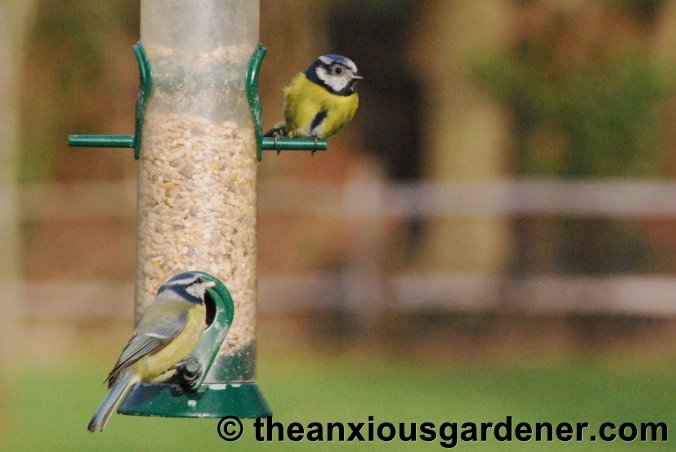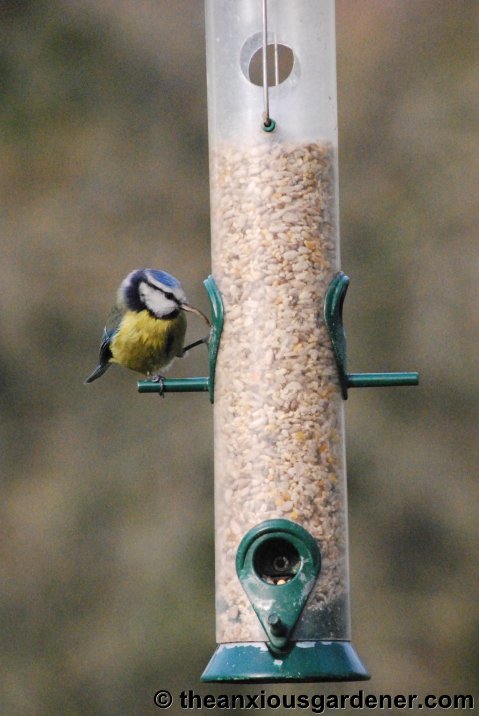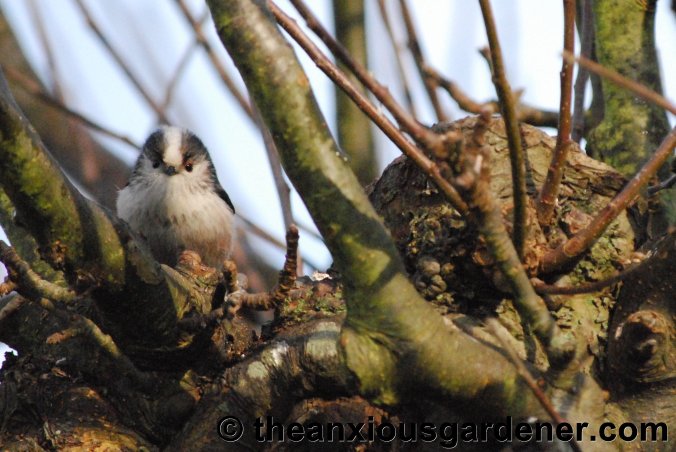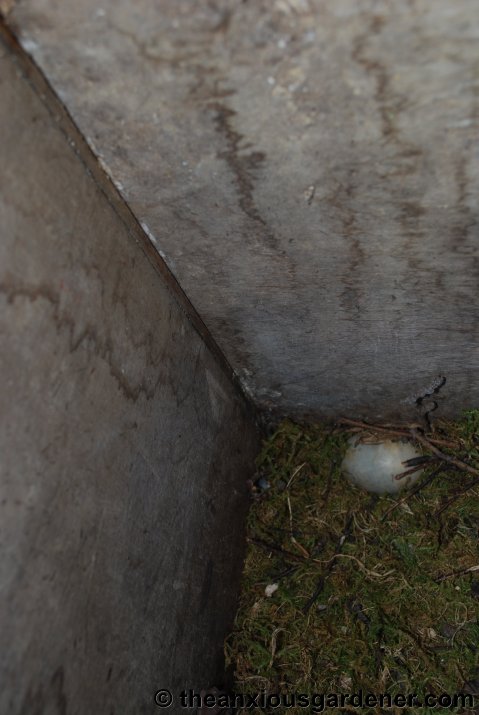I’m back home safe and sound from my winter walking adventure in Yorkshire and Cumbria. It’ll take a few days more to sort through all the photos and come up with some wordsandwordsandwords.
In the meantime …..
A few weeks ago, I posted some photos of blue tits using the bird feeders at the Priory. After first uploading those photos onto my PC, I noticed some rather unsettling details about some of the birds.
For example, this blue tit has some kind of feather baldness (?) around its right eye. Its missing some of its facial colouration and its customary black stripe – not that it seems particularly bothered.
I also had some photos of a great tit which frankly, are too gruesome to publish. The poor thing had a nasty cancerous growth eating up one side of its head. Horribly disfigured, it was still feeding happily enough (hence my photos of it on the feeder) but I do wonder how long it can survive such an affliction. As if life wasn’t difficult enough for these little birds.
And then there was this chap. When I first saw it on the feeder, from a distance, I thought, “How odd. It’s using a stick to feed.”
But when I studied it later on-screen, I realised that the ‘stick’ was actually its beak.
It still manages to feed –
… mostly. Otherwise, it seems healthy enough – though again I wonder how long it might survive with an accoutrement that can’t really be of benefit. Hang on. Unless, unless it’s a new species? Previously unknown to science, living quietly here in the Sussex Weald. In which case I hereby name it Marsden’s Tit! I shall be world-famous!
Thankfully, most garden birds seem to be in …
…robust …
… and hearty …
… good health.
I spent my first morning back at the Priory cleaning out the nest boxes. I’ve made eleven of these: an owl box, a robin/fly-catcher box and nine tit boxes.
After an unfortunate incident with a grey squirrel (beastly creatures) two years ago, I fitted all the boxes with metal plates to stop dratted twitchy-nosed rodents from enlarging the hole and feeding on eggs and baby birds. They seem to work a treat.
Of the nine tit boxes, six were used last year and the other three had evidence of roosting (feathers and droppings). I moved one of the unused ones as it was badly sited and I’m hoping for a better take up rate this year. The robin box still hasn’t been used. Humpf.
I also clambered up a very tall ladder (terribly brave, me) to examine the owl box that mandarin ducks used last year. Inside on a bed of soft moss …
… was a lone addled egg (which I absolutely did NOT throw into Margaret’s field). I never did see any baby mandarins so who knows what happened to them or the other eggs. Underneath the moss was about five inches of foul-smelling gunk and twigs – an old pigeon nest. I obviously forgot to clean out it out last year. The whole bucket of stinky waste that I removed had probably made the box too shallow for tawny owls anyhow (it should be about 32 inches deep). There are so many owl pellets in the garden at the moment (more than I’ve ever seen before) and an abundance of vole holes and tunnels. So come on Tawnies – you’re at the Priory, there’s tons of food. Now just use the flipping box would you?
* Sorry, I meant five.










I have a large number of blue tits in my garden, recently I have found three with disfigurements to their head, one had a large lump on the top of his head and on one eye, the second has a large lump under his beak, what is causing this?
LikeLike
Hi June, it sounds like avian pox. Have a look at this:-
http://www.zsl.org/science/news/avian-pox,842,NS.html
I’ve emailed the RSPB as it seems they want to know of any reports of this disease and to ask whether they have any advice (other than regular cleaning of bird feeders). If I get a reply I’ll post it here asap. Hope that helps. Dave
LikeLike
Hi June, don’t know whether you’re following this thread still but I had a response from the RSPB. I will feature it in a future post as well but for now here it is:
“Blue tits are known to be affected by avian pox, and it is possible that the birds referred to by your correspondent did have the pox virus. Having said that, without a more detailed description on the colour, size and texture of the lumps I would not want to be too definite about it. A smooth grey or brown lumps up to a certain size tend to turn out to be ticks, but if the lump is pink or red, especially if it is more irregular in shape, it is most likely to be a pox lesion. Avian pox is transmitted first and foremost by biting insects, with secondary transmission by direct and indirect contact from an affected bird. The only thing people can do if poxy birds turn up in the garden is to step up the hygiene regime, especially by daily wipe of the feeder perches and seed ports with a disinfectant. There is no necessity to stop feeding. As you know, the RSPB is involved with monitoring incidents of disease in garden birds, currently with particular emphasis on trichomonosis and avian pox. It would be great if you could direct people who say that they have sick birds in the garden to our website http://www.rspb.org.uk/advice/helpingbirds/health/sickbirds/index.aspx They can report the birds by filling in and emailing or posting to us the disease reporting form downloadable from the pages on tricho and pox.
The beaky blue tit in your pictures seems to have a normal lower mandible and a long upper mandible. Abnormal beak growth does happen from time to time, and can result in a whole range of beak shapes. In most cases, this is caused by damage to the beak or its growth point; often mechanical damage through injury, but sometimes also through actions of feather mites that burrow into the growth point of the beak. Normally, if the mandibles end up different lengths, the fact that the beak tips don’t meet, will result in uneven growth of the mandibles resulting in a beak bent in one direction or another. I find your blue tit quite unusual in that the elongated top mandible has grown with only minor curvature without the lower mandible balancing it out. The bird appears in good conditions, so it has clearly adapted to its disfigurement well, although I would have thought that it must have some difficulty picking up and handling food because of the scale of discrepancy in the mandible lengths. beak abnormalities.
D
LikeLike
I suddenly realised that I hadn’t seen any posts from Dave Marsden recently. He couldn’t still be in the pub in Cumbria or stuck in a snow hole, could he? It would seem that i’m just not getting the postson my Dashboard…..
Slightly scary looking disfigurements on these birds. The nuthatch photo is one of the best. To see one not to mention be able to photograph it would be wonderful. I don’t think they get this far north.
LikeLike
Nuthatches are smashing – I didn’t realise you don’t get them that far north. But then they thought that about grass-snakes and I read recently that they have just been discovered north of the border for the first time. Dave
LikeLike
Pingback: End of Month View for February 2012 ( a year on) « Hurtled to 60 and Now Beyond…
Sounds like your feeling refreshed after your winter walking,looking forward to seeing those photos! Mmmm naming a Tit after you now that is …………very funny, beautiful little birds. Do you keep a record of the different types of birds that have visited and seek shelter at the Priory ?
LikeLike
Yes, very refreshed, thanks Andrea. And I do keep a record – though only in my head. There are several that I see but have yet to photo including kingfishers, sparrowhawks, tree-creepers, buzzards and a green sandpiper. And, of course, the elusive owls. Dave
LikeLike
Very strange to see so many disfigured birds, worrying. I love your Robin pic, all puffed up and cocky. You are so lucky to have owls in your area, such beautiful, enchanting creatures. I have’nt seen one in such a long time. Maybe if we make a box and put it up one might come along and take up residence. I love the eerie sound of their hooting. Look forward to seeing pics from your walking adventures.
Bridget.
LikeLike
Hi Bridget, sorry I only just discovered this comment in my spam queue, don’t know why it was there. I once stayed in a cottage in Cornwall, above a farm. And we (there were about twelve of us) would stand transfixed every evening and watch as a pair of barn owls hunted. Beautiful and very eerie. Dave
LikeLike
Poor old misshapes; I wonder if much ‘shunning’ goes on in the bird world. They seem to be doing okay though, and the other birds you’ve captured (not literally!) look positively plumptious. Hope the tawnies move in soon.
LikeLike
That’s what I thought, Sara. No moaning or griping just getting on with survival – whatever the odds.
LikeLike
Squirrels are extra-concentrated bundles of wickedness and spite. I’m glad you’ve managed to foil yours, even if mere foiling’s too good for ’em. (I had one move into my house in VT for a while–Luther took it personally.) The color echoes in the robin photo and the lines and colors in the nuthatch one are just lovely. What on earth were you saying, though, to put them in such a Monday morning-ish sort of mood? Fingers crossed that you get a tawny this year.
LikeLike
The world seeems to b divided by those who find grey squirrels adorable and those that know that they are simply bundles of wickedness and spite. I can imagine Luther trembling with anger – as Hobbes used to. Dogs see through the veneeer of cuteness too. The robin and nuthatch were actually in Yorkshire . It was perishingly cold and I was sat on a (very icy) tree trunk having a sandwich. All the birds were obviously very hungry so I shared my food and they were coming remarkably close and feeding at my feet – nuthatch included which are normally rather shy.
LikeLike
Sooo stunning pictures! 🙂
I especially loved the Robin!
Thanx for sharing!
LikeLike
Hi Bonnie, he’s lovely isn’t he? it was especially cold so he’d really puffed himself up. Little darling.
LikeLike
Hmmm…the Marsden Tit, sure there’s a joke somewhere…off to hunt for it along with the sixth bird box!!
LikeLike
Hi Jane, I did elaborate on the Marsden Tit in the draft but it was getting way too smutty! And we’re all far above that ‘sort of thing.’ If you find the sixth box – do let me know. You have to look very, very, very carefully indeed.
Dave
LikeLike
Nice post to start back with , I had a bluetit with a totally bald head last winter ,havent seen him about this year tho :(. I spent 10 minutes looking for the 6th nest box btw , never one to give up . Look forward to seeing pics from your trip ,youre a very good photographer 🙂
LikeLike
Hi Suzy, I wonder whether the baldness on the first tit’s face won’t spread further – some kind of mange? Perhaps your baldy regrew its feathers (lets be optimistic, eh?). Hehe – and gratifying that you fell for my little joke!
LikeLike
Your photography is stunning as always! Endearing photos of the birds, and also good to see that some of the ones with afflictions (and disfigurement) are still happily feeding away. You’re doing a good job encouraging more birds at the Priory 🙂
LikeLike
It’s a very satisfying aspect to my job, Boys of Luton – and I don’t have to pay for the very considerable amount of bird food they get through!
LikeLike
I am suffering from photo envy! As I am still very much an amateur when it comes to photography please tell me how you manage to obtain such clear and wonderful close ups. Looking forward to seeing the Lake District pics. – Ronnie
btw – why am I not on your links 😉
LikeLike
I’ve tried putting my camera on a tripod and using a remote shutter gizmo but its range is limited so generally I find that the birds have just got pretty used to me and I can stand within 12 or 15 feet with my 200mm lens and photograph them. Of course some birds won’t come when I’m that close including the great spotted woodpecker – who’s a regular visitor – tree-creepers, goldfinches etc.
Sorry – when I transferred from blogger I lost my list of links – but obviously forgot some when I put it back together from memory. Looks like I missed yours – now rectified. Er, though you seem to have forgotten me too! Hehe.
LikeLike
Eek! Hangs head in shame and embarrassment. Now corrected, you are on my blog roll 🙂
LikeLike
Welcome back – great shots of the birds I expect there a lots of disfigured birds around it’s just that we can’t see them as they fly off so quickly you are doing a great job there with the nest boxes.
LikeLike
Thanks Elaine – I’d hoped to make more nestboxes this winter but doubt now I’ll have time. I paticularly wanted to build a barn owl box as Margaret has had them roosting in one of her barns.
LikeLike